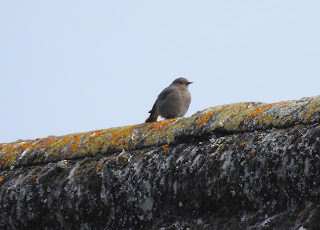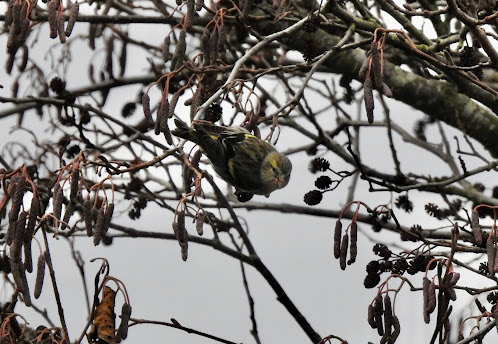Yesterday afternoon I headed for Feckenham Wylde Moor for my final bit of birding of 2022. I ended up sitting in the little hide watching 18 Mallard, chatting to a photographer who had been hoping to see a Kingfisher, and ultimately watching hundreds of Rooks and Jackdaws gathering to roost somewhere to the east. A few Reed Buntings arrived to settle in the reeds for the evening, and a Lesser Redpoll showed well in the gloomy light as I prepared to leave.
It was at least a good opportunity to reflect on a truly excellent year. My final tick had been a Goldeneye at Lower Bittell in mid November, bringing me to a satisfying total of 140 species. But it wasn't all about the year list. I've also been recording birds throughout the 10 km diameter circle around our house. Here is a rather low-tech map of where I have managed to record birds since I started the project at the beginning of November 2021.
 |
| The central 10 km square is SP06 and Redditch occupies most of it. |
So I've endeavoured to map everything I've seen on a one square km basis, and this includes birds, mammals, butterflies, moths, and dragonflies. The purple squares are winter visits, and the grey ones are breeding season efforts. I think it will take me ten years to do it properly, and then I'll have to decide where to show the information gleaned. Now that's what I call a proper project.
Inevitably I kept lists of the wildlife seen this year, and these are the highlights:
Best Finds
I've had to write descriptions for four species. The Honey-buzzard at Morton Bagot in mid July was easily the rarest of these. The others were the Osprey at Earlswood in September, the Black Redstart at Umberslade Park Farm in June, and the Little Gull at Earlswood in April (I wasn't in their WhatsApp Group at that time so I may not have been the first to see it, but I didn't know it was there).
I had to balance visiting new areas of the circle with continuing to visit my actual patch, Morton Bagot. I did this by going to Morton Bagot on Sundays throughout the year, and more often in April/May, and August/September/October. This worked quite well, and a Common Gull which Dave and I saw there in December was patch year tick number 110. So that's only about eight to ten species down on the years when I went nowhere else. Highlights included the aforementioned Honey-buzzard, plus Ring Ouzels, Whimbrel, Great White Egret, Garganey, and Pink-footed Geese. None these were patch ticks, but they were all quality finds.
Twitching highlights
Joining the Earlswood WhatsApp Group and assistance from the likes of Josh Toogood, Neil Duggan, Mark Islip, and Rob Wardle gave me the chance to see birds found by others. The rarest of these were a Red-crested Pochard at Arrow Valley Lake (and two more at Earlswood), some Common Scoters and a Rock Pipit at Earlswood, and a Whooper Swan at Lower Bittell.
If onlys
The year also had its frustrations. I always try hard to find good birds, but there's a fine line between trying hard, and try too hard. A cruel person might describe this as stringing, but I would prefer to call it the "if only" section. I wish it had been empty.
Back in March I was carefully going through the Golden Plover flock at Middletown, thinking if only there was an American Golden Plover with them. Then I found a "funny one" asleep, miles away. On this occasion I managed to teeter and then regain my balance. I concluded the views weren't good enough, and Golden Plovers in early spring vary too much, for me to call it.
If only I'd done the same in April when Dave and I concluded an otherwise excellent day by getting interested in a drake Teal just visible in the grass at the back of the furthest flash.
We thought we could see the tops of two white lines bordering the breast. If only we'd waited a few more minutes before setting off to try to get a better view. The bird must have woken up in our absence and waddled to where we might have seen it properly. Instead, we made the call. Twitchers turned up, while I searched my conscience and fell on my sword. Just a Teal I think. Very embarrassing.
The final "if only" might have brightened an otherwise deadly dull December. Walking our usual route around Morton Bagot we heard a Tree Pipit-like call several times. We were thinking Olive-backed Pipit from the off, but couldn't see the bird. We weren't sure whether it was flying over, or flying around. In the end we gave up. Two days later an Olive-backed Pipit was found in Devon. If only we'd seen the bloody thing (and if only we were better birders).
The birds I missed
Although I was thrilled to see 140 species in the course of the year, other birds were available. Some were potentially twitchable, and I reckon the total seen within the Circle was around 150 species.
There were at least three Oystercatchers, a Pied Flycatcher and a Wood Warbler which I might have seen if I'd been in the Earlswood WhatsApp Group at the time, an Arctic Skua and a Marsh Harrier flew over Earlswood when I wasn't there, and Black-tailed Godwits, Scaup, and several other species I can't call to mind right now which could potentially have formed a part of my list.
Other creatures
One creature I found this year is due to be featured in the April edition of Antenna no less. Never heard of it? No neither had I. But it is the Dipterist's quarterly magazine, and its quite a story.
Back in the summer I notice a tiny insect in the wash basin at home and decided to photograph it.
I couldn't work out what it was after an on-line search, so sent an image to the Royal Entomological Society. The reply was along the lines of "gosh what a smart insect". A day later I found it dead, so offered to send them the corpse. It ended up being posted to an expert in the Czech Republic who confirmed it to be a Gall Midge Lestodiplosis vorax. Not a first for Britain, but an unusual sighting in a little studied group. Fancy that!
My butterfly year was less impressive. I saw the bare minimum of what might be expected, and avoided seeing any White-letter Hairstreaks, Brown Hairstreaks, or Purple Emperors, all of which I believe were seen locally.
My moth tally was a lot better. A visit to a Heart of England Forest "event" added loads of species to my life list, while my garden trapping turned up one or two surprises. The best in terms of local rarity were Shaded Pug and Cream-bordered Green Pea, not to mention several Beet Moths (but everyone got some of those in a year which saw a massive range expansion).
 |
| Shaded Pug |
 |
| Cream-bordered Green Pea |
Finally, Dragonflies also brought me a new species. A Willow Emerald had been found by Sam MacVie at Morton Bagot, and after three attempts I managed to see it. Unfortunately it eluded my camera. Something to try for next year perhaps.
I get the feeling that the much trumpeted "#LocalBigYear" isn't going to happen in 2023, the emphasis in the birding on-line media seems to be on the relaunch of Patchwork Challenge. But I now have a figure to beat, and a project to continue.
So roll on 2023, let's see what it brings.
It only leaves me to wish you all a Happy and wildlife-packed New Year.























